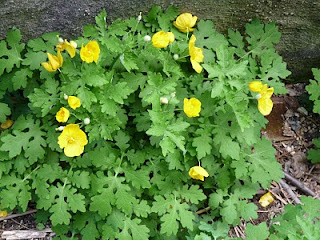

Amaryllis belladonna is one of two species of bulbous plants (the other being the hardier Lycoris squamigera,which has thinner petals and has spring growing foliage) that are known as "naked ladies" due to the fact they flower without the leaves present. The flower stalks of both rise out of the bare ground with suprising speed in August. Amaryllis belladonna is a common sight in California, to the point of occasionally naturalizing, as when I saw some in bloom on a cliff above a beach not far from the San Francisco area a few years ago. It is native to the Cape of South Africa, where it produces leaves in winter, which die off in spring and then the flowers emerge in late summer. It does the same in California, but in the eastern US its habit of putting out winter foliage which may be damaged by severe cold tends to weaken the bulbs over time, and deeply penetrating severe cold may kill the bulbs outright. I think I have found a sweet spot for them, along the wall of my school garden where a couple of bulbs have survived three winters thus far. The foliage does burn from the winter cold, but it continues to grow in spring and dies off in June, apparently long enough to allow the bulb to store enough food for flowers. This past winter was particularly cold early on, but not so cold later on, which may have delayed the leaf growth a bit, so damage was minimized--worse conditions would be warm early winter weather that draws out the foliage followed by severe cold later on to maximize damage. Unlike last summer, this one has been hot and rather dry, which gives the bulbs the kind of preconditioning they like in order to flower, so finally one is in bloom now. Planting them right up against the wall means that the soil probably does not freeze deeply, protecting the bulb, and the foliage can benefit from extra warmth during early spring. Overhanging eves also keep this area drier than the rest of the garden, though I do water it, as can be seen by the Euryops tysonii, Pelargonium luridum, and Dierama surrouding the amaryllis. A nearby group of diascia which made it through the winter (labelled as D. anistrepa ? from Silverhill) and bloomed profusely in spring died during the dry heat of summer in the same area (though it made a precious few seeds from which I can regenerate plants later on).
From what I know, its considered pretty remarkable to get Amaryllis belladonna to bloom in the eastern US, let alone persist more than a year. So I have excitedly (foolishly?) ordered a fairly large batch of mixed colors forms/hybrids (reds, pinks, whites) which will arrive in the next couple of weeks. I will plant them rather thickly close to the wall (I may have to move a few other plants to accomodate them) in the hopes of getting a more substantial display in future years, Mulching will probably be a good idea once the cold weather really sets in, and in any case even under good conditions Amaryllis belladonna bulbs take a year or two to settle down after being moved.

















































